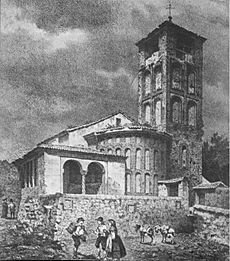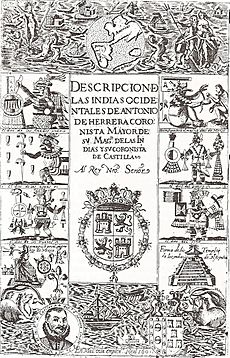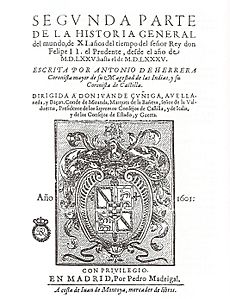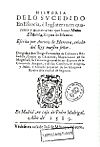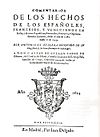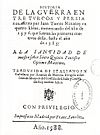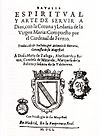Antonio de Herrera y Tordesillas facts for kids
Antonio de Herrera y Tordesillas (1549 – 28 March 1626 or 27 March 1625) was an important Spanish historian and writer. He lived during the Spanish Golden Age, a time of great art and literature in Spain.
He is best known for his book Historia general de los hechos de los castellanos en las Islas y Tierra Firme del mar Océano que llaman Indias Occidentales. This long title means "General History of the Deeds of the Castilians on the Islands and Mainland of the Ocean Sea Known As the West Indies." It is often called Décadas for short. This book is seen as one of the best works about the Spanish conquest of the Americas. It's interesting to know that Herrera never actually visited the Americas himself. He wrote his history using many different sources and official documents.
Antonio de Herrera was the Chief Chronicler for the kings Philip II and Philip III. A chronicler is like an official historian who writes down important events for the government. He was called the "prince of the historians of the Americas" by Cristóbal Pérez Pastor. Herrera wrote many books, including a history of the world and a description of the Americas. He also translated books from Italian and Latin into Spanish.
Modern historians see him as an official historian who used many existing documents. He was very good at collecting information from different sources.
Contents
Biography
Antonio de Herrera was born in Cuéllar, a town in the Province of Segovia, Spain. His family was well-off and noble. His parents were Rodrigo de Tordesillas and Inés de Herrera. He chose to use his mother's last name, Herrera, first. This was different from the usual Spanish naming customs of the time.
He started his studies in his hometown's Latin grammar school. He was very good at meeting people and had a strong work ethic. He likely studied at the University of Salamanca. His education became even better when he traveled to Italy in 1570. There, he worked for Prince Vespasiano I Gonzaga, an important person in Italy. He improved his Latin and learned Italian.
In 1572, Prince Gonzaga became the Viceroy of Navarre. Herrera went with him and lived in Pamplona. He continued to be trusted by the viceroy when Gonzaga moved to Valencia in 1575. Herrera moved to the royal court in Madrid. He worked as Gonzaga's trusted helper, dealing with issues for him before the King. During this time, Herrera made many important friends and started to build his own wealth.
Later, Prince Gonzaga introduced Herrera to King Philip II. This was the start of Herrera's relationship with the King. Herrera began dedicating his historical writings to important people. To impress the King, he translated an Italian book called Historia della guerra fra turchi et persiani.
While living in Pamplona, he met Juana de Esparza y Artieda. They married in 1581. This marriage helped him gain a good social standing. They had one child, a daughter named Juana, who sadly died young in 1587. Her mother, Juana, had died three years earlier.
After being a widower for ten years, he married again. His second wife was María de Torres Hinestrosa, from his hometown of Cuéllar. She came from a noble family. They did not have any children together.
Chronicler
After his first wife died, Herrera focused on building his career at the royal court. He bought property in Madrid and wrote constantly. In 1596, he became the Chief Chronicler of the Americas. Then, in 1598, he also became the Chief Chronicler of Castile. These jobs came with a good salary.
In 1601, he moved to Valladolid with the royal court. He continued his tireless work as a historian there. He also handled court duties and financial matters. In 1607, he returned to Madrid. He lived in a comfortable house near the Puerta del Sol. He continued his writing and enjoyed a good lifestyle. He kept writing historical and literary works until he died.
Death
Antonio de Herrera died in Madrid on 28 March 1626 or 27 March 1625. In his will, he asked to be buried in the Santa Marina church in his hometown of Cuéllar. He wanted his grave to have a special sign with an inscription. His wishes were carried out.
Over the years, his tombstone was moved and used in different ways. In 1886, his remains were moved to the nearby Church of San Pedro. Later, in 1890, they were moved again to the Cuéllar Town Hall. Today, his remains, along with those of his wife and his tombstone, are kept there. The tombstone has an inscription in Latin and Spanish:
|
Ant, Herrera Tordesillas. Chronicu |
Antonio Herrera Tordesillas, chronicler |
Works
Descripción de las Indias Occidentales
Herrera's history of the Americas began with his book Descripción de las Indias. It was published in 1601 and included many maps. Even though it was published as a separate book, it was meant to be an introduction to his main work, Décadas. This book described the geography of the Americas. It helped readers understand the places where the historical events happened.
This book was part of a long tradition of geographical works about the Americas. Herrera used many sources for his Descripción. These included chronicles, sailing guides, and maps from other writers. He used these to create his text and its fourteen maps of the Americas and the Far East. Later editions of his Décadas often included Descripción as a bonus. It was translated into English, German, French, and Latin.
Décadas
Herrera is most famous for his book Historia general de los hechos de los castellanos en las Islas y Tierra Firme del mar Océano que llaman Indias Occidentales. This work is known as Décadas. It was published in four volumes between 1601 and 1615. It is considered the most complete written history of the Americas from that time.
The book focuses on the events experienced by the conquistadors, who were Spanish explorers and conquerors. Herrera had already covered the natural environment in his Descripción. He also felt that other historians had already written about the native peoples. So, his book mainly describes the actions of the Castilians (Spaniards). It tells the story of events without giving too many personal opinions.
The title page of the book had engravings showing temples, native leaders (called caciques), and other parts of the Americas. It also included portraits of Spanish conquistadors. These portraits are a valuable collection of famous conquistadors. Many of them are unique and can't be found anywhere else.
Décadas is important because Herrera used all the available historical sources. Because of his job, he had access to many official documents. This made it the first general history of the Americas to use so many different sources. The book was very popular when it was published. Within a few years, it was translated into Latin, French, and German. Later, it was also translated into Dutch and English. It has been published in twenty editions over time.
Historia general del mundo
Herrera also published a book called Historia general del Mundo (General History of the World). He wrote this during the time of King Philip II. This work is divided into three parts.
The first part covers the years from 1559 to 1574. It was published in Madrid in 1601. The second part covers 1575 to 1585, published at the same time. The third part was published in Madrid in 1612. It covers the period from 1585 to 1598, ending with the king's death. In this book, Herrera wrote about "tumult, rebellions, acts of sedition and treason, uprisings, wars between peoples, captures of cities and castles, sackings, fires, truces, accords, broken treaties, massacres, deaths of princes, and other events." He didn't just write about Spain. He also included events from Africa, Asia, and the oceans.
Other works
Herrera wrote many other books, including:
- Historia de Portugal y conquista de las islas Azores (1582): A history of Portugal and its conquest of the Azores islands.
- Historia de María Estuardo (1589): A book about the life of Mary, Queen of Scots.
- Crónica de los Turcos (1598): A chronicle about the Turks.
- Sucesos de Francia (1598): A history of events in France from 1585 to 1594.
- Sucesos de Milán (1599): A report on events in Milan between 1595 and 1598.
- Tratado de los movimientos de Aragón (1612): A historical account of the events in Aragon in 1591 and 1592.
- Comentarios de los hechos de los españoles, franceses y venecianos en Italia (1624): A book about the deeds of Spaniards, French, and Venetians in Italy.
- Discursos morales, políticos e históricos inéditos (1804): A collection of his moral, political, and historical essays, published long after his death.
Some of his other works are known but no longer exist today.
Translations
Herrera also translated several books from other languages into Spanish:
- Historia de la guerra entre turcos y persianos (1588): Translated from Italian.
- Diez libros de la razón de Estado (1592): Translated from Italian.
- Advertencias que los catholicos de Inglaterra embiaron a los de Francia (1592): Translated from French.
- Batalla espiritual y arte de seruir a Dios (1607): Translated from Italian.
- Los cinco libros primeros de los Annales de Cornelio Tacito (1615): Translated from Latin.
- Descripción de las Indias Occidentales (1622): He even translated his own work into Latin for publication in the Netherlands.
Manuscripts
About fifteen of Herrera's handwritten documents are kept in the Biblioteca Nacional de España (National Library of Spain). These include drafts of his Crónica de los Turcos, essays on French history, and writings on Portuguese history. There are also essays about the laws and customs of the Canary Islands, and various letters and treatises.
See also
 In Spanish: Antonio de Herrera y Tordesillas para niños
In Spanish: Antonio de Herrera y Tordesillas para niños



